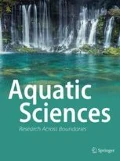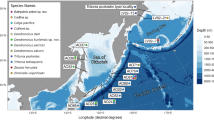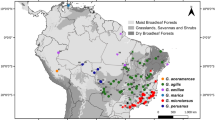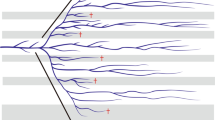Abstract
Distributional, phylogenetic, molecular, and paleontological data may be integrated to discover biogeographic patterns exhibited by the organisms. Cladistic biogeography uses information on the phylogenetic relationships between taxa and their geographic distribution to infer a sequence of area fragmentation. Brooks Parsimony Analysis (BPA) was performed based on the phylogenetic proposals for Cnesterodontini to hypothesize on the historical relationships among nine areas previously recognized by endemism of freshwater fish from South America. Additionally, we investigated the conservation scenario for cnesterodontines based on biogeographic, phylogenetic, and extinction criteria to establish a priority ranking for the analyzed areas. We found that the area relationships for Cnesterodontini are strongly linked to the historical patterns of evolution of the hydrographic basins, revealing well-defined scenarios of the formation of hydrological barriers between coastal river basins (i.e., Atlantic Slope) and mainly drainages running into the La Plata River system (i.e., Inland Slope). Dispersal events through headwater capture and sea-level changes explain the congruences evidenced among other fish lineages that exhibit similar diversification patterns in the Central Brazil drainages and in drainages on the Atlantic coast of South America. The ranking of priority areas for conservation established for Cnesterodontini indicates that greater attention should be directed to the regions located in the Central Coastal and Upper Parana areas, mainly in the Atlantic Forest, which represents one of the most threatened biodiversity hotspots on the planet with serious threats to freshwater biodiversity.



Similar content being viewed by others
Data availability
All data generated or analyzed during this study are included in this published article [and its electronic supplementary information].
References
Abell R, Thieme ML, Revenga C, Bryer M, Kottelat M, Bogutskaya N, Coad B, Mandrak N, Balderas SC, Bussing W, Stiassny MLJ, Skelton P, Allen GR, Unmack P, Naseka A, Ng R, Sindorf N, Robertson J, Armijo E, Higgins JV, Heibel TJ, Wikramanayake E, Olson D, Lopez HL, Reis RE, Lundberg JG, Perez MHS, Petry P (2008) Freshwater ecoregions of the world: a new map of biogeographic units for freshwater biodiversity conservation. Bioscience 58(5):403–414. https://doi.org/10.1641/B580507
Aguilera G, Mirande JM, Azpelicueta MM (2009) A new species of Cnesterodon (Cyprinodontiformes: Poeciliidae) from a small tributary of arroyo Cuñá-Pirú, río Paraná basin, Misiones, Argentina. Zootaxa 2195(1):34–42. https://doi.org/10.11646/ZOOTAXA.2195.1.2
Albert JS, Carvalho TP (2011) Neogene assembly of modern faunas. In: Albert JS, Reis RE (eds) Historical biogeography of Neotropical freshwater fishes. University of California Press, Berkeley and Los Angeles, pp 119–136
Albert JS, Tagliacollo VA, Dagosta F (2020) Diversification of Neotropical freshwater fishes. Annu Rev Ecol Evol Syst 51:27–53. https://doi.org/10.1146/annurev-ecolsys-011620-031032
Álvarez Mondragón E, Morrone JJ (2004) Propuesta de áreas para la conservación de aves de México, empleando herramientas panbiogeográficas e índices de complementariedad. Interciencia 29(3):112–120
Alves GHZ, Santos RS, Figueiredo BRS, Manetta GI, Message HJ, Pazianoto LHR, Guimarães GB, Benedito E, Couto EV (2019) Misguided policy may jeopardize a diverse South Brazilian environmental protection area. Biota Neotrop 19(1):e20180574. https://doi.org/10.1590/1676-0611-BN-2018-0574
Aquino PPU, Colli GR (2017) Headwater captures and the phylogenetic structure of freshwater fish assemblages: a case study in central Brazil. J Biogeogr 44(1):207–2016. https://doi.org/10.1111/jbi.12870
Araújo FG, Peixoto MG, Pinto BCT, Teixeira TP (2009) Distribution of guppies Poecilia reticulata (Peters, 1860) and Phalloceros caudimaculatus (Hensel, 1868) along a polluted stretch of the Paraíba do Sul River, Brazil. Braz J Biol 69(1):41–48. https://doi.org/10.1590/S1519-69842009000100005
Azevedo-Santos VM, Frederico RG, Fagundes CK, Pompeu PS, Pelicice FM, Padial AA, Nogueira MG, Fearnside PM, Lima LB, Daga VS, Oliveira FJM, Vitule JRS, Callisto M, Agostinho AA, Esteves FA, Lima-Junior DP, Magalhães ALB, Sabino J, Mormul RP, Grasel D, Zuanon J, Vilella FS, Henry R (2019) Protected areas: a focus on Brazilian freshwater biodiversity. Divers Distrib 25(3):442–448. https://doi.org/10.1111/ddi.12871
Bertaco VA, Ferrer J, Carvalho FR, Malabarba LR (2016) Inventory of the freshwater fishes from a densely collected area in South America—a case study of the current knowledge of Neotropical fish diversity. Zootaxa 4138(3):401–440. https://doi.org/10.11646/ZOOTAXA.4138.3.1
Brooks DR (1981) Hennig’s parasitological method: a proposed solution. Syst Zool 30(3):229–249. https://doi.org/10.2307/2413247
Brooks DR (1988) Macroevolutionary comparisons of host and parasite phylogenies. Ann Rev Ecol Syst 19:235–259. https://doi.org/10.1146/annurev.es.19.110188.001315
Brooks DR (1990) Parsimony analysis in historical biogeography and coevolution: methodological and theoretical update. Syst Zool 39(1):14–30. https://doi.org/10.2307/2992205
Brooks DR, Van Veller MGP, McLennan DA (2001) How to do BPA, really. J Biogeogr 28(3):345–358. https://doi.org/10.1046/j.1365-2699.2001.00545.x
Caballero-Viñas C, Sánchez-Nava P, Aguilar-Ortigoza C, Morrone JJ (2021) Dispersal of North American Polymorphidae (Acanthocephala) and aquatic birds (Anatidae and Rallidae) along the Central Migratory Flyway. J Zool Syst Evol Res 59(3):561–575. https://doi.org/10.1111/jzs.12450
Casatti L, Teresa FB, Gonçalves-Souza T, Bessa E, Manzotti AR, Gonçalves CS, Zeni JO (2012) From forests to cattail: how does the riparian zone influence stream fish? Neotrop Ichthyol 10(1):205–214. https://doi.org/10.1590/S1679-62252012000100020
Castro RMC (2021) Evolução da ictiofauna de riachos sul-americanos (Castro, 1999) revisitado após mais de duas décadas. Oecol Aust 25(2):231–245. https://doi.org/10.4257/oeco.2021.2502.02
Castro RMC, Polaz CNM (2020) Small-sized fish: the largest and most threatened portion of the megadiverse neotropical freshwater fish fauna. Biota Neotrop 20(1):e20180683. https://doi.org/10.1590/1676-0611-BN-2018-0683
Chuctaya JA, Donin LM, Vieira CS, Faustino-Fuster D, Carvalho TP (2018) First record of Phallotorynus victoriae Oliveros, 1983 (Cyprinodontiformes, Poeciliidae) for Uruguay river basin and Rio Grande do Sul, southern Brazil. Check List 14(1):159–162. https://doi.org/10.15560/14.1.159
Costa WJEM (2010) Historical biogeography of cynolebiasine annual killifishes inferred from dispersal-vicariance analysis. J Biogeogr 37(10):1995–2004. https://doi.org/10.1111/j.1365-2699.2010.02339.x
Crisci JV, Katinas L, Posadas P (2003) Historical biogeography: an introduction. Harvard University Press, Cambridge
Dagosta FCP, de Pinna M (2017) Biogeography of Amazonian fishes: deconstructing river basins as biogeographic units. Neotrop Ichthyol 15(3):e170034. https://doi.org/10.1590/1982-0224-20170034
Eken G, Bennun L, Brooks TM, Darwall W, Fishpool LDC, Foster M, Knox D, Langhammer P, Matiku P, Radford E, Salaman P, Sechrest W, Smith ML, Spector S, Tordoff A (2004) Key Biodiversity Areas as site conservation targets. Bioscience 54(12):1110–1118. https://doi.org/10.1641/0006-3568(2004)054[1110:KBAASC]2.0.CO;2
Fricke R, Eschmeyer WN, Van der Laan R (2022) Eschmeyer’s catalog of fishes: genera, species, references. http://researcharchive.calacademy.org/research/ichthyology/catalog/fishcatmain.asp. Accessed 31 Aug 2022
Frota A, Deprá GC, Petenucci LM, Graça WJ (2016) Inventory of the fish fauna from Ivaí River basin, Paraná State, Brazil. Biota Neotrop 16(3):e20150151. https://doi.org/10.1590/1676-0611-BN-2015-0151
Frota A, Message HJ, Oliveira RC, Benedito E, Graça WJ (2019) Ichthyofauna of headwater streams from the rio Ribeira de Iguape basin, at the boundaries of the Ponta Grossa Arch, Paraná, Brazil. Biota Neotrop 19(1):e20180666. https://doi.org/10.1590/1676-0611-BN-2018-0666
Frota A, Morrone JJ, Graça WJ (2020a) Evolutionary biogeography of the freshwater fish family Anablepidae (Teleostei: Cyprinodontiformes), a marine-derived Neotropical lineage. Org Divers Evol 20(3):439–449. https://doi.org/10.1007/s13127-020-00444-1
Frota A, Ota RR, Deprá GC, Ganassin MJ, Graça WJ (2020b) A new inventory for fishes of headwater streams from the rio das Cinzas and rio Itararé basins, rio Paranapanema system, Paraná, Brazil. Biota Neotrop 20(1):833. https://doi.org/10.1590/1676-0611-BN-2019-0833
Frota A, Pacifico R, Graça WJ (2021) Selecting areas with rare and restricted fish species in mountain streams of Southern Brazil. Aquatic Conserv: Mar Freshw Ecosyst 31(6):1269–1284. https://doi.org/10.1002/aqc.3566
Ganassin MJM, Frota A, Muniz CM, Baumgartner MT, Hahn NS (2020) Urbanisation affects the diet and feeding selectivity of the invasive guppy Poecilia reticulata. Ecol Freshw Fish 29(2):252–265. https://doi.org/10.1111/eff.12511
Ghedotti MJ (2000) Phylogenetic analysis and taxonomy of the poeciloid fishes (Teleostei, Cyprinodontiformes). Zool J Linn Soc 130(1):1–53. https://doi.org/10.1111/j.1096-3642.2000.tb02194.x
Goloboff P, Farris JS, Nixon KC (2008) TNT, a free program for phylogenetic analysis. Cladistics 24(5):774–786. https://doi.org/10.1111/j.1096-0031.2008.00217.x
Hrbek T, Seckinger J, Meyer A (2007) A phylogenetic and biogeographic perspective on the evolution of poeciliid fishes. Mol Phylogenet Evol 43:986–998. https://doi.org/10.1016/j.ympev.2006.06.009
Hubert N, Renno JF (2006) Historical biogeography of South American freshwater fishes. J Biogeogr 33(8):1414–1436. https://doi.org/10.1111/j.1365-2699.2006.01518.x
Humphries CJ, Parenti LR (1999) Cladistic biogeography: interpreting patterns of plant and animal distributions. Oxford University Press, Oxford
ICMBio – Instituto Chico Mendes de Conservação da Biodiversidade (2018) Livro Vermelho da Fauna Brasileira Ameaçada de Extinção. ICMBio/MMA, Brasília
Ingenito LFS, Buckup PA (2007) The Serra da Mantiqueira, south-eastern Brazil, as a biogeographical barrier for fishes. J Biogeogr 34(7):1173–1182. https://doi.org/10.1111/j.1365-2699.2007.01686.x
IUCN Standards and Petitions Committee (2019) Guidelines for using the IUCN Red List categories and criteria. Version 14. Prepared by the Standards and Petitions Subcommittee. http://www.iucnredlist.org/documents/RedListGuidelines.pdf. Accessed 31 Aug 2022
Lemes P, Melo AS, Loyola RD (2014) Climate change threatens protected areas of the Atlantic Forest. Biodivers Conserv 23(2):357–368. https://doi.org/10.1007/s10531-013-0605-2
Lima SMQ, Vasconcellos AV, Berbel-Filho WM, Lazoski C, Russo CAM, Sazima I, Solé-Cava A (2016) Effects of Pleistocene climatic and geomorphological changes on the population structure of the restricted-range catfish Trichogenes longipinnis (Siluriformes: Trichomycteridae). Syst Biodivers 14(2):155–170. https://doi.org/10.1080/14772000.2015.1104398
Lima SMQ, Berbel-Filho WM, Araújo TFP, Lazzarotto H, Tatarenkov A, Avise JC (2017) Headwater capture evidenced by paleo-rivers reconstruction and population genetic structure of the armored catfish (Pareiorhaphis garbei) in the Serra do Mar mountains of Southeastern Brazil. Front Genet 8:199. https://doi.org/10.3389/fgene.2017.00199
Lima SMQ, Berbel-Filho WM, Vilasboa A, Lazoski C, Volpi TA, Lazzarotto H, Russo CAM, Tatarenkov A, Avise JC, Solé-Cava AM (2021) Rio de Janeiro and other palaeodrainages evidenced by the genetic structure of an Atlantic Forest catfish. J Biogeogr 48(6):1475–1488. https://doi.org/10.1111/jbi.14091
Loureiro M, Duarte A, Zarucki M (2011) A new species of Austrolebias Costa (Cyprinodontiformes: Rivulidae) from northeastern Uruguay, with comments on distribution patterns. Neotrop Ichthyol 9(2):335–342. https://doi.org/10.1590/s1679-62252011000200010
Lucinda PHF (2005) Systematics of the genus Cnesterodon Garman, 1895 (Cyprinodontiformes: Poeciliidae: Poeciliinae). Neotrop Ichthyol 3(2):259–270. https://doi.org/10.1590/S1679-62252005000200003
Lucinda PHF (2008) Systematics and biogeography of the genus Phalloceros Eigenmann, 1907 (Cyprinodontiformes: Poeciliidae: Poeciliinae), with the description of twenty-one new species. Neotrop Ichthyol 6(2):113–158. https://doi.org/10.1590/S1679-62252008000200001
Lucinda PHF, Graça WJ (2015) Description of males of Phallotorynus pankalos Lucinda, Rosa & Reis, 2005 and reappraisal of Phallotorynus species relationships (Teleostei: Cyprinodontiformes: Poeciliidae). Neotrop Ichthyol 13(1):87–92. https://doi.org/10.1590/1982-0224-20140071
Lucinda PHF, Reis RE (2005) Systematics of the subfamily Poeciliinae Bonaparte (Cyprinodontiformes: Poeciliidae), with an emphasis on the tribe Cnesterodontini Hubbs. Neotrop Ichthyol 3(1):1–60. https://doi.org/10.1590/S1679-62252005000100001
Lucinda PHF, Rosa RS, Reis RE (2005) Systematics and biogeography of the genus Phallotorynus Henn, 1916 (Cyprinodontiformes: Poeciliidae: Poeciliinae), with description of three new species. Copeia 2005(3):609–631. https://doi.org/10.1643/CI-04-183R1
Lucinda PHF, Litz T, Recuero R (2006) Cnesterodon holopterus (Cyprinodontiformes: Poeciliidae: Poeciliinae) a new species from the Republic of Uruguay. Zootaxa 1350(1):21–31. https://doi.org/10.11646/zootaxa.1350.1.2
Machado CB, Galetti PM Jr, Carnaval AC (2018) Bayesian analyses detect a history of both vicariance and geodispersal in Neotropical freshwater fishes. J Biogeogr 45(6):1313–1325. https://doi.org/10.1111/jbi.13207
Magalhães ALB, Jacobi CM (2013) Invasion risks posed by ornamental freshwater fish trade to southeastern Brazilian rivers. Neotrop Ichthyol 11(2):433–441. https://doi.org/10.1590/S1679-62252013005000003
Magalhães ALB, Jacobi CM (2017) Colorful invasion in permissive Neotropical ecosystems: establishment of ornamental non-native poeciliids of the genera Poecilia/Xiphophorus (Cyprinodontiformes: Poeciliidae) and management alternatives. Neotrop Ichthyol 15(1):e160094. https://doi.org/10.1590/1982-0224-20160094
Mezzaroba L, Debona T, Frota A, Graça WJ, Gubiani ÉA (2021) From the headwaters to the Iguassu Falls: inventory of the ichthyofauna in the Iguassu River basin shows increasing percentages of nonnative species. Biota Neotrop 21(2):e20201083. https://doi.org/10.1590/1676-0611-BN-2020-1083
Morais-Silva JP, Oliveira AV, Fabrin TMC, Diamante NA, Prioli SMAP, Frota A, Graça WJ, Prioli AJ (2018) Geomorphology influencing the diversification of fish in small-order rivers of neighboring basins. Zebrafish 15(4):389–397. https://doi.org/10.1089/zeb.2017.1551
Morais-Silva JP, Scorsim B, Gonçalves G, Frota A, Graça WJ, Oliveira AV (2023) Molecular markers reveal a new and possibly threatened species of Cnesterodon (Poeciliidae, Cnesterodontini) from the upper Paraná River basin, Brazil. Zebrafish. https://doi.org/10.1089/zeb.2022.0052
Morrone JJ (1999) How can biogeography and cladistics interact for the selection of areas for biodiversity conservation? A view from Andean weevils (Coleoptera: Curculionidae). Biogeographica 75:89–96
Morrone JJ (2009) Evolutionary biogeoraphy: an integrative approach with case studies. Columbia University Press, New York
Morrone JJ (2020) The Mexican Transition Zone: a natural biogeographic laboratory to study biotic assembly. Springer, Cham
Myers N (1988) Threatened biotas: “Hot spots” in tropical forests. Environmentalist 8(3):187–208. https://doi.org/10.1007/BF02240252
Myers NA, Mittermeier RA, Mittermeier GC, da Fonseca GAB, Kent J (2000) Biodiversity hotspots for conservation priorities. Nature 403:853–858. https://doi.org/10.1038/35002501
Nihei SS (2016) Biogeografia cladística. In: Carvalho CJ, Almeida EAB (eds) Biogeografia da América do Sul: análise de tempo, espaço e forma, 2nd edn. São Paulo, Roca, pp 35–56
Nixon KC (2002) Winclada, Version 1.00.08. Published by the author
Parenti LR, Ebach MC (2009) Comparative biogeography: discovering and classifying biogeographical patterns of a dynamic Earth. University of California Press, Berkeley and Los Angeles
Parenti LR, Rauchenberger M (1989) Systematic overview of the poeciliins. In: Meffe GK, Snelson FF (eds) Ecology and Evolution Of Livebearing Fishes (Poeciliidae). Prentice Hall Inc., Englewood Cliffs, pp 3–12
Piálek L, Říčan O, Casciotta J, Almirón A, Zrzavý J (2012) Multilocus phylogeny of Crenicichla (Teleostei: Cichlidae), with biogeography of the C. lacustris group: species flocks as a model for sympatric speciation in rivers. Mol Phylogenet Evol 62(1):46–61. https://doi.org/10.1016/j.ympev.2011.09.006
Platnick NI, Nelson G (1978) A method of analysis for historical biogeography. Syst Zool 27(1):1–16. https://doi.org/10.2307/2412808
Posadas P, Miranda-Esquivel DR, Crisci JV (2001) Using phylogenetic diversity measures to set priorities in conservation: an example from Southern South America. Conserv Biol 15(5):1325–1334. https://doi.org/10.1111/j.1523-1739.2001.99404.x
Ramos-Fregonezi AMC, Malabarba LR, Fagundes NJR (2017) Population genetic structure of Cnesterodon decemmaculatus (Poeciliidae): a freshwater look at the Pampa biome in Southern South America. Front Genet 8:214. https://doi.org/10.3389/fgene.2017.00214
Reis RE, Albert JS, Di Dario F, Mincarone MM, Petry P, Rocha LA (2016) Fish biodiversity and conservation in South America. J Fish Biol 89(1):12–47. https://doi.org/10.1111/jfb.13016
Reis RB, Frota A, Deprá GC, Ota RR, Graça WJ (2020) Freshwater fishes from Paraná State, Brazil: an annotated list, with comments on biogeographic patterns, threats, and future perspectives. Zootaxa 4868(4):451–494. https://doi.org/10.11646/zootaxa.4868.4.1
Ribeiro AC (2006) Tectonic history and the biogeography of the freshwater fishes from the coastal drainages of eastern Brazil: an example of faunal evolution associated with a divergent continental margin. Neotrop Ichthyol 4(2):225–246. https://doi.org/10.1590/S1679-62252006000200009
Ribeiro MC, Metzger JP, Martensen AC, Ponzoni FJ, Hirota MM (2009) The Brazilian Atlantic Forest: how much is left, and how is the remaining forest distributed? Implications for Conservation. Biol Conserv 142(6):1141–1153. https://doi.org/10.1016/j.biocon.2009.02.021
Ribeiro AC, Lima FCT, Menezes NA (2016) Biogeografia dos peixes de água doce da América do Sul. In: Carvalho CJ, Almeida EAB (eds) Biogeografia da América do Sul: análise de tempo, espaço e forma, 2nd edn. Roca, São Paulo, pp 245–258
Ribeiro AC, Riccomini C, Leite JAD (2018) Origin of the largest South American transcontinental water divide. Sci Rep 8:17144. https://doi.org/10.1038/s41598-018-35554-6
Říčan O, Říčanová S, Dragová K, Piálek L, Almirón A, Casciotta J (2019) Species diversity in Gymnogeophagus (Teleostei: Cichlidae) and comparative biogeography of cichlids in the Middle Paraná basin, an emerging hotspot of fish endemism. Hydrobiologia 832(1):331–354. https://doi.org/10.1007/s10750-018-3691-z
Rosen DE (1978) Vicariant patterns and historical explanation in biogeography. Syst Zool 27(2):159–188. https://doi.org/10.2307/2412970
Rosen DE, Bailey RM (1963) The Poeciliid fishes (Cyprinodontiformes) their structure, zoogeography and systematics. Bull Am Mus Nat Hist 126(1):1–176
Silva JFM, Jerep FC, Bennemann ST (2015) New record and distribution extension of the endangered freshwater fish Cnesterodon hypselurus (Cyprinodontiformes: Poeciliidae) in the upper Paraná River basin, Brazil. Check List 11(6):1811. https://doi.org/10.15560/11.6.1811
SOS Mata Atlântica, INPE (2021) Atlas dos remanescentes florestais da Mata Atlântica: período 2019–2020. Technical Report. http://www.sosmatatlantica.org.br. Accessed 31 Aug 2022
Souto-Santos ICA, Ferraro GA, Jennings WB, Vergara GLS, Buckup PA (2019) Geographic distribution of Phalloceros Eigenmann, 1907 (Cyprinodontiformes, Poeciliidae) in the Ilha Grande Bay Hydrographic Region, Rio de Janeiro, Brazil. Check List 15(1):181–192. https://doi.org/10.15560/15.1.181
Souto-Santos ICA, Jennings WB, Buckup PA (2022) Testing palaeodrainage hypotheses in south-eastern Brazil: phylogeography of the sinistral livebearer fish of the genus Phalloceros (Cyprinodontiformes: Poeciliidae). Zool J Linn Soc. https://doi.org/10.1093/zoolinnean/zlac030
Stockwell CA, Henkanaththegedara SM (2011) Evolutionary conservation biology. In: Evans JP, Pilastro A, Schlupp I (eds) Ecology and evolution of Poeciliid fishes. University of Chicago Press, Chicago, pp 128–141
Tagliacollo VA, Roxo FF, Duke-Sylvester SM, Oliveira C, Albert JS (2015) Biogeographical signature of river capture events in Amazonian lowlands. J Biogeogr 42(12):2349–2362. https://doi.org/10.1111/jbi.12594
Tagliacollo VA, Dagosta FCP, de Pinna M, Reis RE, Albert JS (2021) Assessing extinction risk from geographic distribution data in Neotropical freshwater fishes. Neotrop Ichthyol 19(3):e210079. https://doi.org/10.1590/1982-0224-2021-0079
Tedesco PA, Oberdorff T, Lasso CA, Zapata M, Hugueny B (2005) Evidence of history in explaining diversity patterns in tropical riverine fish. J Biogeogr 32(11):1899–1907. https://doi.org/10.1111/j.1365-2699.2005.01345.x
Thomaz AT, Knowles LL (2018) Flowing into the unknown: inferred paleodrainages for studying the ichthyofauna of Brazilian coastal rivers. Neotrop Ichthyol 16(3):e180019. https://doi.org/10.1590/1982-0224-20180019
Thomaz AT, Knowles LL (2020) Commom barriers, but temporal dissonance: genomic tests suggest ecological and paleo-landscape sieves structure a coastal riverine fish community. Mol Ecol 29(4):783–796. https://doi.org/10.1111/mec.15357
Thomaz AT, Malabarba LR, Bonatto SL, Knowles LL (2015) Testing the effect of palaeodrainages versus habitat stability on genetic divergence in riverine systems: study of a Neotropical fish of the Brazilian coastal Atlantic Forest. J Biogeogr 42(12):2389–2401. https://doi.org/10.1111/jbi.12597
Thomaz AT, Carvalho TP, Malabarba LR, Knowles LL (2019) Geographic distributions, phenotypes, and phylogenetic relationships of Phalloceros (Cyprinodontiformes: Poeciliidae): insights about diversification among sympatric species pools. Mol Phylogenet Evol 132:265–274. https://doi.org/10.1016/j.ympev.2018.12.008
Tschá MK, Bachmann L, Abilhoa V, Boeger WA (2017) Past connection and isolation of catchments: the sea-level changes affect the distribution and genetic variability of coastal freshwater fishes. Estuar Coast Shelf Sci 190:31–39. https://doi.org/10.1016/j.ecss.2017.02.030
Tumini G, Giri F, Williner V, Collins PA, Morrone JJ (2018) Distributional patterns of endemic southern South American freshwater aeglids (Crustacea: Decapoda: Anomura: Aeglidae). Zool Anz 277:55–64. https://doi.org/10.1016/j.jcz.2018.06.004
Tumini G, Giri F, Williner V, Collins PA, Morrone JJ (2019) Selecting and ranking areas for conservation of Aegla (Crustacea: Decapoda: Anomura) in southern South America integrating biogeography, phylogeny and assessments of extinction risk. Aquatic Conserv: Mar Freshw Ecosyst 29(5):693–705. https://doi.org/10.1002/aqc.3098
Vane-Wright R, Humphries C, Williams P (1991) What to protect? Systematics and the agony of choice. Biol Conserv 55(3):235–254. https://doi.org/10.1016/0006-3207(91)90030-D
Wendt EW, Silva PC, Malabarba LR, Carvalho TP (2019) Phylogenetic relationships and historical biogeography of Oligosarcus (Teleostei: Characidae): examining riverine landscape evolution in southeastern South America. Mol Phylogenet Evol 140:106604. https://doi.org/10.1016/j.ympev.2019.106604
Wiley EO (1988a) Parsimony analysis and vicariance biogeography. Syst Zool 37(3):271–290. https://doi.org/10.1093/sysbio/37.3.271
Wiley EO (1988b) Vicariance biogeography. Annu Rev Ecol Syst 19:513–542. https://doi.org/10.1146/annurev.es.19.110188.002501
Zwiener VP, Padial AA, Marques MCM, Faleiro FV, Loyola R, Townsend Peterson A (2017) Planning for conservation and restoration under climate and land use change in the Brazilian Atlantic Forest. Divers Distrib 23(8):955–966. https://doi.org/10.1111/ddi.12588
Acknowledgements
We are deeply grateful to reviewers for their helpful comments and suggestions that significantly improved this manuscript; to PEA (Programa de Pós-Graduação em Ecologia de Ambientes Aquáticos Continentais) and Fundação Araucária (SETI/PR) for the financial support given to AF for his research stay in Mexico. We thank CNPq (Conselho Nacional de Desenvolvimento Científico e Tecnológico) for productivity scholarships conceived to WJG (305200/2018-6 and 307089/2021-5) and for a postgraduation (141242/2018-3) and postdoctoral (168348/2022-5) scholarships conceived to AF.
Funding
Fundação Araucária (SETI/PR) and CNPq (Conselho Nacional de Desenvolvimento Científico e Tecnológico), Grants/Award Numbers: 141242/2018-3, 307089/2021-5, 305200/2018-6, and 168348/2022-5.
Author information
Authors and Affiliations
Contributions
AF and WJG conceived and AF and JJM designed the investigations; AF and JJM performed the biogeographic analysis; JJM and WJG contributed to data interpretation, critical revision, and adding intellectual content. All authors interpreted the data and wrote the manuscript.
Corresponding author
Ethics declarations
Conflict of interest
The authors declare that they have no conflict of interest.
Ethical approval
This article does not use animals and does not contain any studies with human participants performed by any of the authors.
Additional information
Publisher's Note
Springer Nature remains neutral with regard to jurisdictional claims in published maps and institutional affiliations.
Supplementary Information
Below is the link to the electronic supplementary material.
Rights and permissions
Springer Nature or its licensor (e.g. a society or other partner) holds exclusive rights to this article under a publishing agreement with the author(s) or other rightsholder(s); author self-archiving of the accepted manuscript version of this article is solely governed by the terms of such publishing agreement and applicable law.
About this article
Cite this article
Frota, A., Morrone, J.J. & da Graça, W.J. Evolutionary biogeography of Cnesterodontini (Teleostei: Poeciliidae): area relationships and priority ranking for conservation. Aquat Sci 85, 50 (2023). https://doi.org/10.1007/s00027-023-00947-x
Received:
Accepted:
Published:
DOI: https://doi.org/10.1007/s00027-023-00947-x




